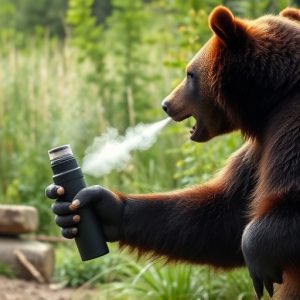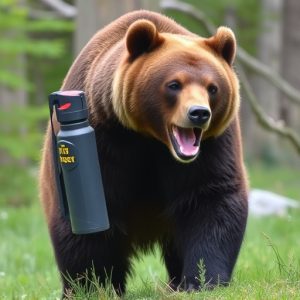Bear Spray Ingredients & Safety: Capsaicin Oleoresin & Best Practices
Mastering bear spray techniques is crucial for safety in bear country. Capsaicin oleoresin, a chili…….
Mastering bear spray techniques is crucial for safety in bear country. Capsaicin oleoresin, a chili pepper compound, disrupts bears' senses from 20-30 feet away. Key strategies include easy access, proper range, targeted application (face and body), and regular maintenance. The best technique varies by activity and location, with higher SCU for hiking and smaller canisters for backpacking. Always follow local regulations and expert advice for optimal protection.
“Uncovering the Power of Bear Spray: Active Ingredients, Safety Tips & Choosing the Right Defense
Bears can pose a significant threat in outdoor environments, but understanding bear spray and its active ingredients is key to staying safe. This article delves into the science behind capsaicin oleoresin, one of the primary components, and explains how it repels bears effectively. We’ll guide you through best practices for carrying and using bear spray safely, ensuring your peace of mind while exploring nature. Additionally, learn crucial factors when selecting the right bear spray to suit your needs, including understanding the best carrying techniques for optimal protection.”
- Understanding Bear Spray: Active Ingredients and Their Function
- The Science Behind Capsaicin Oleoresin: How It Works
- Best Practices for Carrying and Using Bear Spray Safely
- Choosing the Right Bear Spray: Factors to Consider for Optimal Protection
Understanding Bear Spray: Active Ingredients and Their Function
Bear spray is a crucial tool for anyone venturing into bear country, designed to deter and defend against aggressive bears. At its heart, it contains capsaicin oleoresin, the same active ingredient found in chili peppers. This compound stimulates the bear’s sensory organs, causing them to retreat due to the intense irritation.
When carried effectively, the best bear spray techniques involve keeping it readily accessible, understanding the recommended range of use (typically 20-30 feet), and practicing proper application methods. By knowing how to deploy this potent defense, individuals can enhance their safety while enjoying outdoor activities in bear habitats.
The Science Behind Capsaicin Oleoresin: How It Works
The Science Behind Capsaicin Oleoresin: How It Works
Bear spray, a powerful deterrent against aggressive bears, relies on capsaicin oleoresin as its primary active ingredient. This compound is derived from chili peppers and is known for its intense heat sensation. When used in bear spray, capsaicin oleoresin irritates the bear’s eyes, nose, and respiratory system, temporarily disorienting it and creating an escape route for humans. The spray’s aerosol delivery system ensures that the capsaicin reaches these sensitive areas, making it an effective self-defense mechanism in bear country.
Understanding how capsaicin oleoresin works is crucial when discussing the best bear spray carrying techniques. Carrying a reliable bear spray on hikes or camping trips through known bear habitats involves knowing its range and effectiveness. Most bear sprays have a range of 20 to 30 feet, so users must learn proper application techniques. This includes aiming for the face and body of an attacking bear, ensuring a thorough coating that will stick to fur and potentially enter the animal’s eyes and nose, maximizing the spray’s impact.
Best Practices for Carrying and Using Bear Spray Safely
When carrying bear spray, it’s crucial to understand and adhere to best practices for safety. Always keep your bear spray easily accessible, ideally in a belt pouch or within immediate reach. Ensure the canister is secure and won’t fall or shift abruptly during movement. Regularly check the spray’s expiration date and ensure proper functionality by testing it periodically. Familiarize yourself with local regulations regarding bear spray possession and usage.
Using bear spray effectively requires understanding its range and application. Aim for the face, eyes, and nose of the approaching bear, as these areas are most sensitive to capsaicin oleoresin, the active ingredient. Keep a safe distance—typically 20-30 feet—and use the spray when a brown bear shows signs of aggression or approaches closely. After deployment, retreat immediately and monitor your surroundings for any signs of bear activity.
Choosing the Right Bear Spray: Factors to Consider for Optimal Protection
When selecting a bear spray, understanding its active ingredients is key. The primary component, capsaicin oleoresin, derived from chili peppers, is renowned for its effectiveness in deterring bears. This powerful irritant targets a bear’s sensory organs, temporarily blinding and disorienting it. However, not all bear sprays are created equal. Factors like concentration (measured in SCU or spray units), canisters’ size and design, and the inclusion of other agents like pain relievers or numbing agents influence performance.
Optimal protection demands considering your specific needs when choosing the best bear spray carrying techniques. Activities like hiking in known bear country necessitate higher concentrations for increased range and duration of effect. Smaller canisters are ideal for minimalism while backpacking, whereas larger ones offer peace of mind during extended stays in remote areas. Always familiarize yourself with local regulations regarding bear deterrents and consult experts for tailored advice.
In conclusion, understanding the active ingredients in bear spray, particularly capsaicin oleoresin, is key to effective protection during encounters with bears. By adopting best practices for carrying and using bear spray safely, and choosing the right spray based on specific needs, individuals can enhance their outdoor safety, ensuring a more enjoyable and secure experience in bear country. For those seeking expert guidance on the best bear spray carrying techniques, there are numerous resources available to help make informed decisions.


